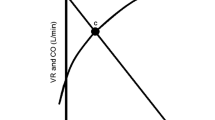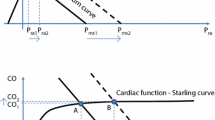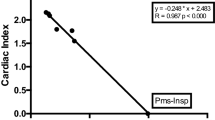Abstract
Objective
The volemic status of a patient can be determined by measuring mean systemic filling pressure (Pmsf). Pmsf is obtained from the venous return curve, i.e. the relationship between central venous pressure (Pcv) and blood flow. We evaluated the feasibility and precision of Pmsf measurement.
Methods
In ten piglets we constructed venous return curves using seven 12 s inspiratory holds transiently increasing Pcv to seven different steady state levels and monitored the resultant blood flow, by pulse contour (COpc) and by flow probes around the pulmonary artery (COr) and aorta (COl). Pmsf is obtained by extrapolation of the venous return curve to zero flow. Measurements were repeated to evaluate the precision of Pmsf.
Results
During the inspiratory holds, 133 paired data points were obtained for COr, COl, COpc and Pcv. Bland–Altman analysis showed no difference between COr and COl, but a small significant difference was present between COl and COpc. All Pcv versus flow (COl or COpc) relationships were linear. Mean Pmsf was 10.78 with COl and 10.37 mmHg with COpc. Bland–Altman analysis for Pmsf with COl and with COpc, showed a bias of 0.40 ± 0.48 mmHg. The averaged coefficient of variation for repeated measurement of Pmsf with COl was 6.2% and with COpc 6.1%.
Conclusions
During an inspiratory hold pulmonary flow and aortic flow equilibrate. Cardiac output estimates by arterial pulse contour and by a flow probe around the aorta are interchangeable. Therefore, the venous return curve and Pmsf can be estimated accurately by pulse contour methods.
Similar content being viewed by others
References
Gelman S. Venous function and central venous pressure: a physiologic story. Anesthesiology. 2008;108:735–748.
Marik PE, Baram M, Vahid B. Does central venous pressure predict fluid responsiveness? A systematic review of the literature and the tale of seven mares. Chest. 2008;134:172–178.
Versprille A, Jansen JR. Mean systemic filling pressure as a characteristic pressure for venous return. Pflugers Arch. 1985;405:226–233.
Magder S. Clinical usefulness of respiratory variations in arterial pressure. Am J Respir Crit Care Med. 2004;169:151–155.
Michard F, Teboul JL. Predicting fluid responsiveness in ICU patients: a critical analysis of the evidence. Chest. 2002;121:2000–2008.
Berkenstadt H, Margalit N, Hadani M, et al. Stroke volume variation as a predictor of fluid responsiveness in patients undergoing brain surgery. Anesth Analg. 2001;92:984–989.
Magder S, Lagonidis D, Erice F. The use of respiratory variations in right atrial pressure to predict the cardiac output response to PEEP. J Crit Care. 2001;16:108–114.
Reuter DA, Felbinger TW, Kilger E, et al. Optimizing fluid therapy in mechanically ventilated patients after cardiac surgery by on-line monitoring of left ventricular stroke volume variations. Comparison with aortic systolic pressure variations. Br J Anaesth. 2002;88:124–126.
Chappell D, Jacob M, Hofmann-Kiefer K, et al. A rational approach to perioperative fluid management. Anesthesiology. 2008;109:723–740.
Guyton AC, Lindsey AW, Abernathy B, Richardson T. Venous return at various right atrial pressures and the normal venous return curve. Am J Physiol. 1957;189:609–615.
Guyton AC. Determination of cardiac output by equating venous return curves with cardiac response curves. Physiol Rev. 1955;35:123–129.
Maas JJ, Geerts BF, van den Berg PC, et al. Assessment of venous return curve and mean systemic filling pressure in postoperative cardiac surgery patients. Crit Care Med. 2009;37:912–918.
Den Hartog EA, Versprille A, Jansen JR. Systemic filling pressure in intact circulation determined on basis of aortic versus central venous pressure relationships. Am J Physiol. 1994;267:H2255–H2258.
Geerts BF, Maas JJ, Aarts LP, et al. Partitioning the resistances along the vascular tree: effects of dobutamine and hypovolemia in piglets with an intact circulation. J Clin Monit Comput. 2010;24:377–384.
Hiesmayr M, Jansen JR, Versprille A. Effects of endotoxin infusion on mean systemic filling pressure and flow resistance to venous return. Pflugers Arch. 1996;431:741–747.
Jansen JR, Schreuder JJ, Bogaard JM, et al. Thermodilution technique for measurement of cardiac output during artificial ventilation. J Appl Physiol. 1981;51:584–591.
Jansen JR, Schreuder JJ, Settels JJ, et al. An adequate strategy for the thermodilution technique in patients during mechanical ventilation. Intensive Care Med. 1990;16:422–425.
Jansen JR, Schreuder JJ, Punt KD, et al. Mean cardiac output by thermodilution with a single controlled injection. Crit Care Med. 2001;29:1868–1873.
Jansen JR, Maas JJ, Pinsky MR. Bedside assessment of mean systemic filling pressure. Curr Opin Crit Care. 2010;16:231–236.
Jellinek H, Krenn H, Oczenski W, et al. Influence of positive airway pressure on the pressure gradient for venous return in humans. J Appl Physiol. 2000;88:926–932.
Schipke JD, Heusch G, Sanii AP, et al. Static filling pressure in patients during induced ventricular fibrillation. Am J Physiol Heart Circ Physiol. 2003;285:H2510–H2515.
Jansen JR. Standard pulse contour methods are not applicable in animals. Intensive Care Med. 2006;32:2084–2085.
Langewouters GJ, Wesseling KH, Goedhard WJ. The static elastic properties of 45 human thoracic and 20 abdominal aortas in vitro and the parameters of a new model. J Biomech. 1984;17:425–435.
Samar RE, Coleman TG. Mean circulatory pressure and vascular compliances in the spontaneously hypertensive rat. Am J Physiol. 1979;237:H584–H589.
Honda T, Fuqua JM, Edmonds CH, et al. Applications of total artificial heart for studies of circulatory physiology; measurement of resistance to venous return in postoperative awake calves. Preliminary report. Ann Biomed Eng. 1976;4:271–279.
Pinsky MR. Instantaneous venous return curves in an intact canine preparation. J Appl Physiol. 1984;56:765–771.
Guyton AC, Polizo D, Armstrong GG. Mean circulatory filling pressure measured immediately after cessation of heart pumping. Am J Physiol. 1954;179:261–267.
Author information
Authors and Affiliations
Corresponding author
Additional information
Maas JJ, Geerts BF, Jansen JRC. Evaluation of mean systemic filling pressure from pulse contour cardiac output and central venous pressure.
Rights and permissions
About this article
Cite this article
Maas, J.J., Geerts, B.F. & Jansen, J.R.C. Evaluation of mean systemic filling pressure from pulse contour cardiac output and central venous pressure. J Clin Monit Comput 25, 193–201 (2011). https://doi.org/10.1007/s10877-011-9294-0
Received:
Accepted:
Published:
Issue Date:
DOI: https://doi.org/10.1007/s10877-011-9294-0




